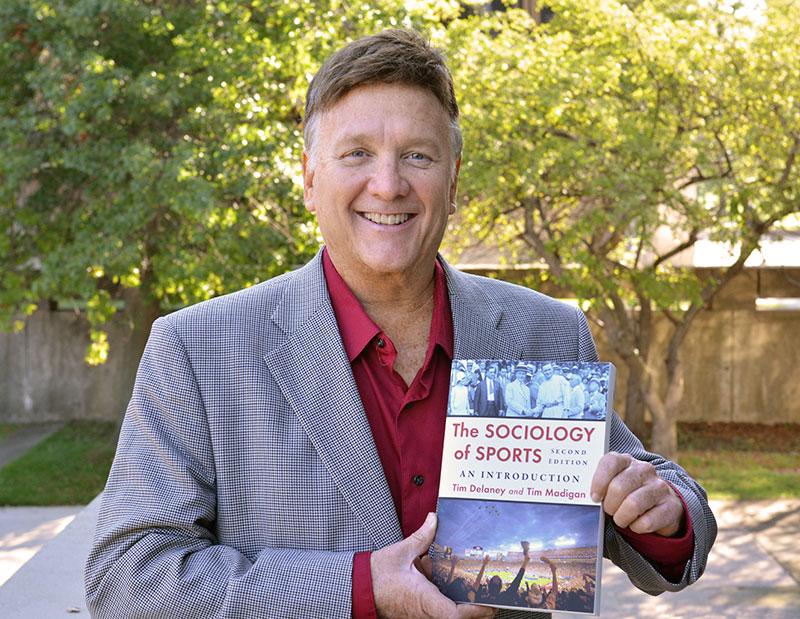Sports as microcosm—Tim Delaney, professor and chair of sociology, has teamed with co-author Tim Madigan of St. John Fisher College to update “The Sociology of Sports: An Introduction” The book’s second edition brings current the pervasive influence of sport in society, engaging such subjects as fantasy sports, video gaming and the influence of gambling, as well as race and ethnicity, concussions, domestic violence and much more.
From domestic violence, concussions and on-field assaults to video gaming, fantasy sports and online gambling, SUNY Oswego’s Tim Delaney and co-author Tim Madigan of St. John Fisher College have teamed to update “The Sociology of Sports: An Introduction” for the latest generation of students and fans.
The book’s second edition, published in August by McFarland & Co., adds 130 pages, connects sports with popular culture and brings current the “sport as a microcosm of society” theme that infuses today’s sports pages and shows, according to Delaney, professor and chair of SUNY Oswego’s sociology department.
McFarland suggested a new edition of the book, first published in 2009, as Delaney was pitching a new book on sportsmanship.
“I was really pleased they wanted us to do a second edition. It sends a message that the first edition is selling well and has a positive reception,” said Delaney, who uses the book as a text in his own course on the sociology of sports.
The 459-page book has about one-third new content, he said, and brings current many issues within sports—on every level, from youth to senior, amateur to professional—that society deals with today. For example, where does a parent’s prerogative to discipline children end and corporal punishment as a form of assault begin? What about violence between spouses?
“The topic of domestic violence was taboo in the past,” Delaney said. “By talking about domestic violence in a sports context, some people feel more comfortable engaging it. Yet that inevitably leads to a discussion that this is not just happening in sports—the far bigger problem is domestic violence in society in general.”
In a chapter on youth sports, the book amplifies on the positive aspects of sports—character building, play, socialization, physical development and entertainment—as well as examining such issues as concussions, parent-induced stress, drug use and violence. And, as with each chapter, it ties in popular culture, using the acclaimed movie “The Blind Side” to probe issues around providing sports opportunities for youngsters who are less fortunate.
Exploring new territory
Delaney said the book also deals with topics not often found in sports-sociology textbooks: junior college sports; the NAIA (National Association of Intercollegiate Athletics), a conference that keys on colleges with small, character-driven athletics programs; and divisions II and III college athletics.
“I work at a Division III school. I played Division III sports,” he said. “Sports and their impacts are universal, not just at the big-time college and professional levels.”
In the chapter “What’s Trending in Sports,” the authors discuss sociological aspects of video gaming—competitions can pack arenas in some cities—as well as the exploding fantasy sports scene, the influence of online and sports-book gambling and such positive developments as sports competitions for those with special needs and schools that are countering childhood obesity and poor sportsmanship.
In the book’s concluding anecdote, parallel with Delaney’s and Madigan’s writing partnership, the authors recall a SUNY Oswego-St. John Fisher baseball incident that drew national attention: With the Lakers leading 9-5 in a game in 2008, a line drive off the bat of one of his own players struck and knocked unconscious then-Oswego coach Frank Paino. As an ambulance was summoned to transport Paino to the hospital, Fisher’s coaches and players huddled and decided to concede the game to Oswego, a decision that ended the Cardinals’ season.
“It’s important to note that sometimes good sportsmanship does receive the recognition it deserves,” the authors write.
Delaney and Madigan also have co-written two books on sustainability. Delaney’s own titles include “American Street Gangs,” “Classical and Contemporary Social Theory: Investigation and Application” and “Seinology: The Sociology of Seinfeld.”




